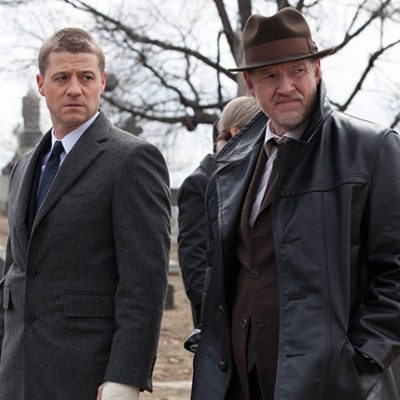
As seen in both city street shots and Steiner Studios/Navy Yard sets, one of Fox TV series Gotham’s central characters is its gritty, shade-thrown viewscapes
by matt scanlon and susan hornik
When writer and executive producer Bruno Heller (Rome, The Mentalist) was conceiving the Fox show Gotham, there were more than a few conceptual challenges in the way. Not least among them was that the unavoidable and inherently central character of Batman was depicted in the show as just a boy, horrifyingly fresh on the heels of his parents’ murder, but years before the adult Bruce Wayne would be absorbed by his caped alter ego. At least initially, the concept looked to be counterintuitive at the very least (somewhat like staging a performance of Hamlet without Hamlet), but Heller’s creation has turned into a resounding success for the network; not only was it extended from an initial run of 16 shows to 22 in its first season, Fox recently announced a re-up for season two.
As critical as cast selection and writing was to the show’s execution, arguably, its setting and cinematography (the latter courtesy of David Stockton, Thomas Yatsko, and Chris Norrthat) make the series fascinatingly unique. Gotham City is depicted as a swirling, windswept, often filthy yet still starkly beautiful expanse of shadows, dangerous corners and lairs–a place where even penthouses and tony nightclubs seem fraught with potentially disastrous possibilities. Part of the secret to achieving this look is the show’s propensity to shoot both on actual New York City streets and in carefully chosen and meticulously designed sets at Steiner Studios at the Brooklyn Navy Yard.
“It’s an urban story, it’s about city life. I think often it’s kind of a dream world that everybody shares,” Heller told us at the TV Critics Press Tour earlier this year. “Everyone has a vision of Gotham in their mind, so you really have to create a three-dimensional world that is both believable but a notch above reality…that has that fantastic element.”
Depicting New York reality would be a starting point on that creative journey, but certainly not an end in itself to Heller. His task, instead, was to capture our urban essence and amplify it in extremity.
“Me and [executive producer/director] Danny Cannon talked a lot about New York in the ’70s as a kind of tone poem for what Gotham is, and that was at a time when the city was falling apart,” explained Heller. “But I remember going there
“[We] talked a lot about New York in the ‘70s as a kind of tone poem for what Gotham is…the decay and the decadence and the anarchy that was, at the same time, joyous and thrilling and exciting and sexy.” —Exec. Prod. Bruno Heller
and it was precisely the decay and the decadence and the anarchy that was, at the same time, joyous and thrilling and exciting and scary and sexy…There is something about a great city as it falls apart that you are compelled to watch. So, it’s a story of downfall, but it’s also a story of sort of explosive growth and excitement.”
Cannon, whose previous credits include CSI, Nikita, and The Lottery, was inspired by a variety of hard-edged movies, as well as music he’s listened to over the years.
“I re-watched a bunch of films that were top 10 movies for me…[William] Friedkin’s films, and Sidney Lumet, and even The Warriors,” he said. “Punk rock came into mind, and I looked at a photo book of the Bowery in New York when CBGB’s club was there. I looked at pictures of Blondie and The Ramones and Iggy Pop, and a lot of the costumes [on Gotham] came from that. The de-saturated look and the dense contrast came from that research.”
Tasked with playing the central role of the series, the eventually-to-be-commissioner James Gordon, actor Benjamin McKenzie had to describe Gordon’s unerring sense of righteousness and virtue, but also how he is changed by the dirt and corruption in his midst. Fresh off his law officer role in NBC’s Southland, McKenzie saw various connections between the two roles.
“The overall similarity’s probably in the mentality of law enforcement officers,” he offered at the same TV Critics event. “The sense of wanting to really uphold a sense of morality and making sure laws are enforced to the letter whenever possible. I just got an email from a guy, a former LAPD cop—who did some of our tactical training on Southland—congratulating me on Gotham. They captured a serial killer recently who was on the run in Los Angeles, blowing people away with shotguns. There’s bad stuff that happens in real life. In Gotham, it’s more that we want to keep a sense of realism, but at the same time, it is fantastical and meant to be a little bit more approachable in the sense that it’s not so starkly drawn.” The actor and Austin Texas native (though he now makes his home in the city) went on to detail that Gotham’s approach was also distinct from Southland’s in that—however chiaroscuro its city sets might be—the overall approach was of a slightly lighter touch.
“In Southland, it was so real, that I think at times it could be quite frightening. In Gotham, I think we wanted to have a little bit more fun with it. We want to feel free to take a certain amount of liberty with tactical stuff and just kind of give it more of a throwback to kind of an old-school gumshoe show, a film-noir kind of conceit, with a little bit of cop tactics thrown in.”



